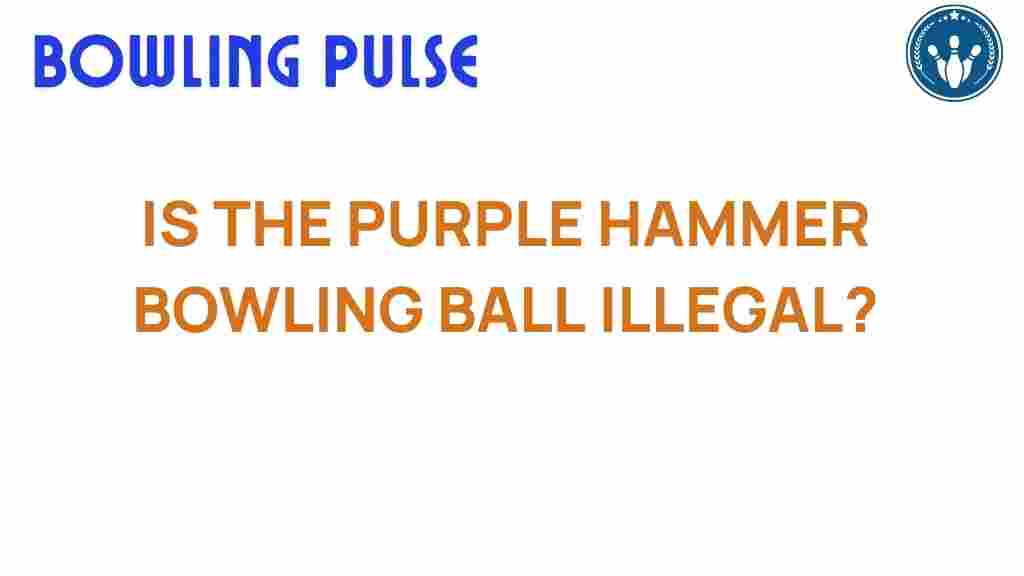Unraveling the Mystery: Is the Purple Hammer Bowling Ball Illegal?
The world of bowling is filled with various types of equipment, each designed to enhance performance and improve the game. Among these, the Purple Hammer bowling ball has garnered significant attention and sparked heated debates regarding its legality. This article aims to delve deep into the controversy surrounding the Purple Hammer, examining its design, performance, and the sports regulations that dictate its use in competitive play.
Understanding the Purple Hammer Bowling Ball
The Purple Hammer is a high-performance bowling ball produced by Hammer Bowling. Known for its distinctive purple color and unique coverstock, this ball is favored by many professional and amateur bowlers alike. But what makes it so special? Here’s a breakdown:
- Coverstock: The Purple Hammer features a urethane cover that is designed to provide a smoother and more controlled reaction on the lane.
- Core Design: The ball boasts a symmetric core that promotes consistent roll and stability.
- Finish: With a 500/1000/2000 Siaair finish, it offers optimal traction on various lane conditions.
These attributes contribute to the ball’s popularity, but they have also raised questions about its legality in sanctioned events.
The Legality of Bowling Equipment
Bowling equipment, including balls, is subject to regulations set by various governing bodies, such as the United States Bowling Congress (USBC). These regulations are in place to ensure fair play and maintain the integrity of the sport. Here’s how legality is determined:
- Specifications: Bowling balls must meet specific size, weight, and material criteria.
- Testing: Balls are often tested for performance metrics, such as hook potential and trajectory.
- Approval Lists: Only balls on the USBC approved list are considered legal for use in sanctioned events.
To determine the legality of the Purple Hammer, it’s essential to consider these factors and how they apply to this particular bowling ball.
The Controversy Surrounding the Purple Hammer
In recent years, the Purple Hammer has been at the center of a significant controversy. Some bowlers and coaches claim that the ball’s performance exceeds the limits set by regulations, leading to accusations of it being “illegal.” Here are some key points of the controversy:
- Performance Claims: Many users report that the Purple Hammer outperforms other balls in terms of hook and overall pin action.
- Regulatory Scrutiny: The USBC has conducted tests on the ball, leading to mixed opinions about its compliance with existing regulations.
- Community Division: The bowling community is split, with some defending the ball’s legality while others call for stricter enforcement of rules.
Step-by-Step: Evaluating the Legality of the Purple Hammer
To assess whether the Purple Hammer bowling ball is illegal, consider the following steps:
1. Review USBC Regulations
Start by reviewing the USBC regulations regarding bowling balls. Pay attention to specifications like weight, diameter, and the type of coverstock used.
2. Check the Approved List
Visit the official USBC website and check the list of approved bowling balls. If the Purple Hammer is on the list, it is legal for sanctioned play.
3. Analyze Performance Data
Look for any performance data or testing results published by USBC or independent organizations. These can provide insights into how the ball performs under competitive conditions.
4. Consult with Experts
Seek opinions from coaches or professional bowlers who have experience with the Purple Hammer. They can provide valuable insights into its legality and performance.
Bowling Techniques with the Purple Hammer
Using the Purple Hammer effectively requires understanding specific bowling techniques that maximize its performance. Here are some tips:
- Grip: Ensure that your grip is consistent for a controlled release.
- Release Point: Focus on a smooth and accurate release point to enhance the ball’s reaction on the lane.
- Adjusting to Lane Conditions: Adapt your technique based on the oil pattern on the lanes to make the most of the ball’s capabilities.
Troubleshooting Common Issues
If you find that your Purple Hammer is not performing as expected, consider the following troubleshooting tips:
- Check for Damage: Inspect the ball for cracks or dents that could affect its performance.
- Adjust Surface Texture: Experiment with different surface textures to find the best match for your bowling style and lane conditions.
- Consult a Pro Shop: If issues persist, consult a professional at a bowling pro shop for expert advice and possible re-drilling or resurfacing.
Conclusion: Is the Purple Hammer Bowling Ball Illegal?
The legality of the Purple Hammer bowling ball remains a contentious issue within the bowling community. While it is on the USBC approved list, ongoing debates about its performance and compliance with regulations continue to spark discussions among bowlers and officials alike. Understanding the specifications and regulations surrounding bowling equipment is crucial for any competitor, especially when it comes to the performance-enhancing potential of balls like the Purple Hammer.
As the sport evolves, so too do the rules and regulations. For bowlers aiming to compete at the highest levels, staying informed about the latest developments in bowling equipment legality is essential. Whether you are a seasoned pro or a weekend warrior, knowing your gear can make all the difference in your game.
For more information on bowling regulations, check out the USBC official guidelines. If you’re looking for tips on improving your bowling techniques, visit our bowling tips page.
Ultimately, the Purple Hammer bowling ball is a tool, and like any tool, its effectiveness depends on the skill and knowledge of the person using it. Embrace the challenge, and may your strikes be plentiful!
This article is in the category Equipment and created by BowlingPulse Team
